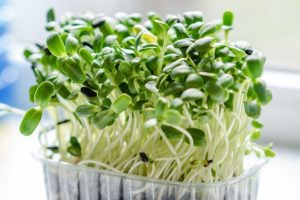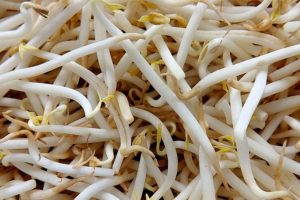 Have you ever watched cooking shows or read food magazines and noticed those tiny, vibrant leafy greens that chefs use as the finishing touch on their dishes?
Have you ever watched cooking shows or read food magazines and noticed those tiny, vibrant leafy greens that chefs use as the finishing touch on their dishes?
They look a little bit like sprouts, but they are actually much different…
…they are microgreens!
Microgreens have been growing in popularity and are now available at many farmers’ markets and even in a few grocery stores. They first started showing up in the 1980s in some fine dining establishments in California. Now, you can find them all across the county, and not just in the fancy restaurants…plus, you can even grow your own!
What are microgreens?
 Basically, they are “mini-versions” of a variety of herbs, plants and vegetables. The seeds are planted in soil (or a soil substitute), and then they are harvested once the stems and leaves reach about 1″ to 3″ tall. This typically occurs within 7 to 14 days, so they are an excellent option for those impatient gardeners out there!
Basically, they are “mini-versions” of a variety of herbs, plants and vegetables. The seeds are planted in soil (or a soil substitute), and then they are harvested once the stems and leaves reach about 1″ to 3″ tall. This typically occurs within 7 to 14 days, so they are an excellent option for those impatient gardeners out there!
Once the seeds germinate, microgreens do best in natural sunlight, although many people are now growing them with artificial lighting. Depending on the lighting and location, they typically do best with anywhere from 5 hours to 12 hours or more of light. The temperature and the pH of the soil are also important to grow the best microgreens.
The variety of microgreens has grown significantly over the past few years. Some of the more popular varieties include arugula, basil, broccoli, beets, kale, cilantro, radishes, carrots, peas, sunflower, chard, fennel, mustard greens and parsley. Especially at the farmers’ markets, you can often find mixes of a variety of herbs and veggies.
How are microgreens different than sprouts?
 Sprouts are typically grown in dark, warm and wet conditions. The seed usually germinates in water and is not planted. They are often ready to consume within as little as 48 hours and you eat the whole thing – the germinated seed, root, stem and undeveloped leaves.
Sprouts are typically grown in dark, warm and wet conditions. The seed usually germinates in water and is not planted. They are often ready to consume within as little as 48 hours and you eat the whole thing – the germinated seed, root, stem and undeveloped leaves.
Sprouts tend to have a much milder flavor and are used primarily for texture in wraps, stir-fries and a variety of other dishes.
Microgreens are different in several ways.
As mentioned above, microgreens are typically grown in soil and light over a 7-to-14-day period. You typically don’t eat the seeds or the roots of microgreens. Instead, you harvest them above the soil and eat the stems and leaves. And, microgreens tend to have a much more vibrant color and intense flavor compared to sprouts.
Some people avoid sprouts because of the risk of unwanted bacteria and Salmonella. Because microgreens are grown in soil and with light, this risk is greatly reduced, especially if you are buying from a reputable producer.
Why include microgreens in your routine?
Not only are they a nutritional powerhouse, they are so much fun to include in your meals in many different ways:
- Nutrition: while they may be tiny, they are packed with nutrients. They are loaded with antioxidants like polyphenols (which help reduce cholesterol and inflammation) and are a great source of vitamins and minerals (including vitamins C, E and K). It’s estimated that microgreens can have five times greater level of nutrients compared to the “adult versions.”
- Visual appeal: it is amazing how some vibrant colored microgreens can liven up an otherwise not so exciting looking dish. The Mushroom Tortilla Pizza as a perfect example…it tastes delicious, but wouldn’t be much to look at without the addition of some brightly colored microgreens (or mature greens like arugula). Remember, we eat with all of our senses, including sight!
- Flavor: for their size, they provide a powerful punch of flavor. It’s fun to experiment with different varieties – sunflowers tend to have a nutty flavor, while peas add a slight sweetness and radishes can provide a spicy kick.
- Texture: whether adding them to a salad, pizza, tacos or other dishes, they can add another great texture to your meal.
Where can you get them?
 Over the past couple of years, we have had a steady supply of microgreens from vendors at our local farmers’ markets. The availability in grocery stores is still pretty limited. One of our local stores sold “living trays” (trays of microgreens that were still growing that we brought home and harvested ourselves), but we haven’t seen these recently. Keep in mind, they are perishable, and their quality and flavor will decline after they are harvested. It is best to enjoy them within a few days of bringing them home.
Over the past couple of years, we have had a steady supply of microgreens from vendors at our local farmers’ markets. The availability in grocery stores is still pretty limited. One of our local stores sold “living trays” (trays of microgreens that were still growing that we brought home and harvested ourselves), but we haven’t seen these recently. Keep in mind, they are perishable, and their quality and flavor will decline after they are harvested. It is best to enjoy them within a few days of bringing them home.
Grow them yourself?!
Yes, if you have an interest, it is worth giving it a try! You can grow them in just about anything, even a plastic cup! There are a number of resources available that provide guidance on how to grow them and many kits are now available (some even provide their own lighting). Keep in mind, they don’t regrow after you harvest them. However, your new seeds will be ready to harvest again in just a week or two. If you stage them appropriately, you can have microgreens available all year long.
The best part…how to enjoy them!
In our experience, they are best eaten raw (vs. cooked). Because of their color, flavor and texture, there are endless ways to enjoy them! We love adding them as a topping on salads, and on sandwiches, wraps, pizzas and tacos. They are delicious as a topping on pasta dishes, curries, soups, and even omelets and frittatas. Some people add them to smoothies, although we prefer to enjoy them whole vs. blending them up in a smoothie. If you are looking for some inspiration, here are just a few ideas:
Orange Farro Salad with Spring Veggies
Tuna Lettuce Wraps with Mango & Jalapeno
Mediterranean Roasted Eggplant Pasta
 Steak & Roasted Vegetable Medley
Steak & Roasted Vegetable Medley
Please share with us, have you experienced microgreens?
What is your favorite way to enjoy them?
 LEARN MORE ABOUT THE NAPKIN!
LEARN MORE ABOUT THE NAPKIN!



Leave A Comment